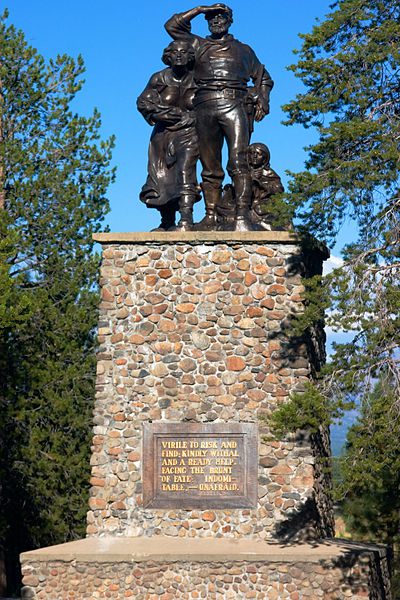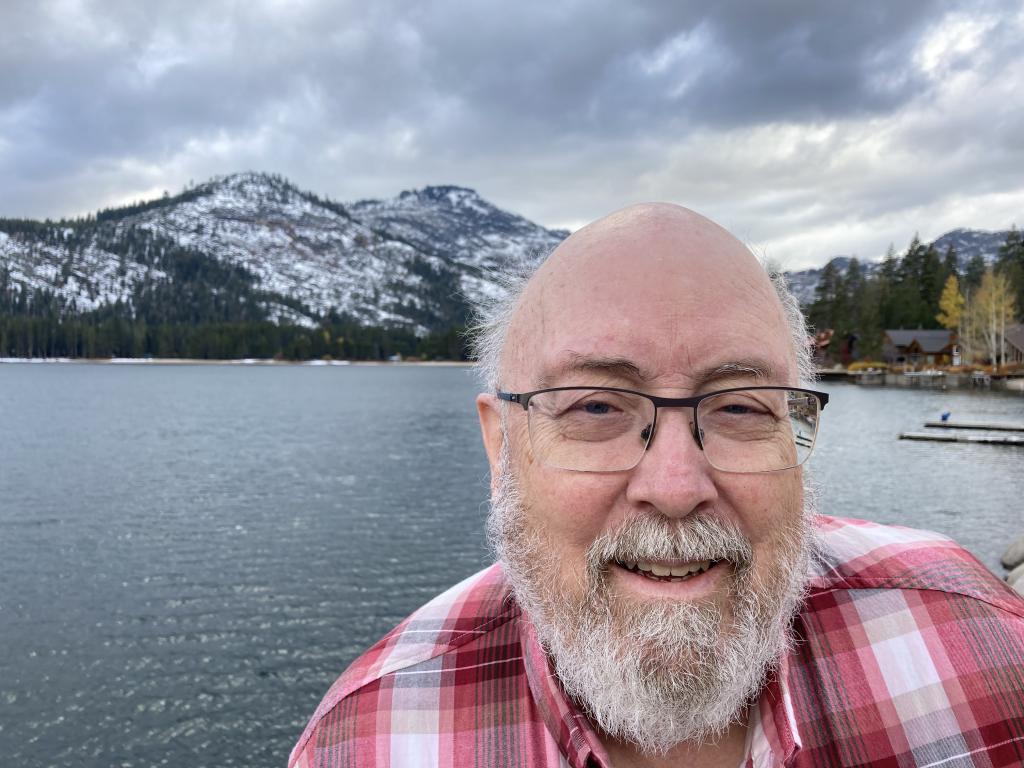
Wikimedia Commons public domain photo by Seano1
The pedestal of the statue is 22 feet high, indicating the depth of the snow in this region of the Sierra Nevada Mountains of California during the fatal winter of 1846-1847.
***
Here in the United States of America and in more than a few other places, the Halloween season is upon us. So here is my 2021 Halloween offering, in Meridian Magazine:
“Ways of Remembering the Dead”
With that in mind, I suppose it was appropriate that my wife and I devoted part of our time today to revisiting Donner Memorial State Park and working our way through the exhibits there. Tragic and sad as the story of the Donner Party is — 46 of the 91 members of the wagon train (slightly more than half) died, according to the official brochure that we were given — it’s also a cautionary tale of the consequences that can follow from rejecting sound counsel and relying, instead, upon untried and foolish advice from people who don’t know what they’re talking about.
I am, by the way, very late in calling this to your attention. But you still might be able to make some use of it:
“New Resources Help You Share Messages of Faith, Hope During Day of the Dead”
See also this:
“Celebrating Día de los Muertos”
And here’s a little piece that I wrote for the official Church website back in 2008:
Everyone Else Makes Such Lonely Heavens [1]
For these defects, and for no other evil,
we now are lost and punished just with this:
we have no hope and yet we live in longing.
Dante’s Inferno[2]
The New Testament states unequivocally that, besides Jesus Christ, “there is none other name under heaven given among men whereby we must be saved.”[3] And yet hundreds of millions of souls, probably the majority of all who have ever lived, were never taught about Christianity and perhaps never so much as heard the name of Jesus Christ. Are these millions of souls lost for the eternities? If so, can God be considered just, let alone merciful?
The poet Dante Alighieri, upon entering (fictionally) into the next world, was astonished by what he saw: “I should never have believed,” he wrote in his Inferno, “that death could have unmade so many souls.”[4] Strikingly, despite his obvious admiration for Socrates, Plato, Aristotle, the great Islamic philosophers Avicenna and Averroës, and the chivalrous Muslim military hero Saladin, Dante felt obliged to place them all in Hell.[5] Even his guide, companion and “kindly master,” the Roman poet Virgil, was eternally barred from heaven. Virgil explains the reason to Dante as follows:
I’d have you know, before you go ahead,
they did not sin; and yet, though they have merits,
that’s not enough, because they lacked baptism,
the portal of the faith that you embrace.
And if they lived before Christianity,
they did not worship God in fitting ways;
and of such spirits I myself am one.
For these defects, and for no other evil,
we now are lost and punished just with this:
we have no hope and yet we live in longing.[6]
The founding Mormon prophet, Joseph Smith, proclaimed a much more generous and expansive view of eternal possibilities. He pointed out that even the New Testament itself suggests a hopeful escape from this troubling prospect, citing the Apostle Paul’s reference to a practice long since forgotten or ignored by mainstream Christianity.[7]
Else what shall they do which are baptized for the dead,
if the dead rise not at all? Why are they then baptized for
the dead?[8]
Though vicarious or “proxy” baptism is but briefly mentioned in the Bible, a restoration of this ancient Christian practice became a foundational doctrine of the Latter-day Saint faith.
Today, members of The Church of Jesus Christ of Latter-day Saints labor to gather genealogical records and to construct temples[9] in which baptisms for the dead and related ordinances can be performed. In striking contrast to the horrific atrocities committed by men and governments in the course of history, this vicarious temple service extends the love of God, with full salvational access, to every human who ever lived.
Proxy temple work best reflects the foundational Latter-day Saint conviction that the power of the atonement of Christ extends even to those who did not hear: every person who has ever lived is to be individually remembered, labored for and valued, thus vindicating the justice of God and illustrating the breadth of his redemptive love. Any rite performed in a Latter-day Saint temple on behalf of a deceased person, who yet lives as a spirit being, is a rite of offering only, exacting no forced compliance nor acceptance of the rite. There is no imposed change of identity, heritage or religious belief, nor is the individual’s name added to the membership rolls of The Church of Jesus Christ of Latter-day Saints.
Editor’s Note: This commentary is one in a series of brief summaries written in 2005 for the 200-year commemoration of Joseph Smith’s birth. Drawing from Joseph Smith’s writings and teachings, these summaries explain the doctrinal foundation of The Church of Jesus Christ of Latter-day Saints. Though far from comprehensive, these summaries provide a brief overview of Joseph Smith’s ideas and beliefs relating to theological, religious and social topics.
Notes:
[1]Tom McHenry, “Mormons Offer Post-Mortem Baptism,” The Exponent Online, 8 Dec. 2003, http://archive.purdueexponent.org/interface/bebop/showstory.php?date=2003/12/08§ion=columns&storyid=ProxyBaptism.
[2] Allen Mandelbaum, trans., The Divine Comedy of Dante Alighieri: Inferno (Toronto and New York: Bantam Books, 1982), canto 4, lines 33-41.
[4] Inferno, canto 3, lines 56-57.
[6] Inferno, canto 4, lines 33-41.
[7]Some individual contemporary Christian thinkers have noticed it. See, for example, Stephen T. Davis, Risen Indeed: Making Sense of the Resurrection (Grand Rapids: Eerdmans, 1993), pp. 159-65, where the author, a philosopher affiliated with Claremont McKenna College in California, cautiously mentions the passage while expressing hope for the unevangelized. Historians have also begun to notice the practice (e.g., Jeffrey A. Trumbower, Rescue for the Dead: The Posthumous Salvation of Non-Christians in Early Christianity [New York: Oxford University Press, 2001]).
[8]1 Corinthians 15:29, quoted by Joseph Smith in a letter to the Church elders in Great Britain, 15 Dec. 1840, Nauvoo, Illinois; in Joseph Smith, Teachings of the Prophet Joseph Smith, sel. Joseph Fielding Smith (Salt Lake City: Deseret Book Co., 1976), p. 179.
[9] Latter-day Saint temples, of which there are 140 constructed or announced worldwide [now, as of the end of October 2021, there are a total of 265 announced, under construction, or dedicated], are distinct in purpose from meetinghouses or chapels, of which there are thousands.

Posted from Northstar, California












